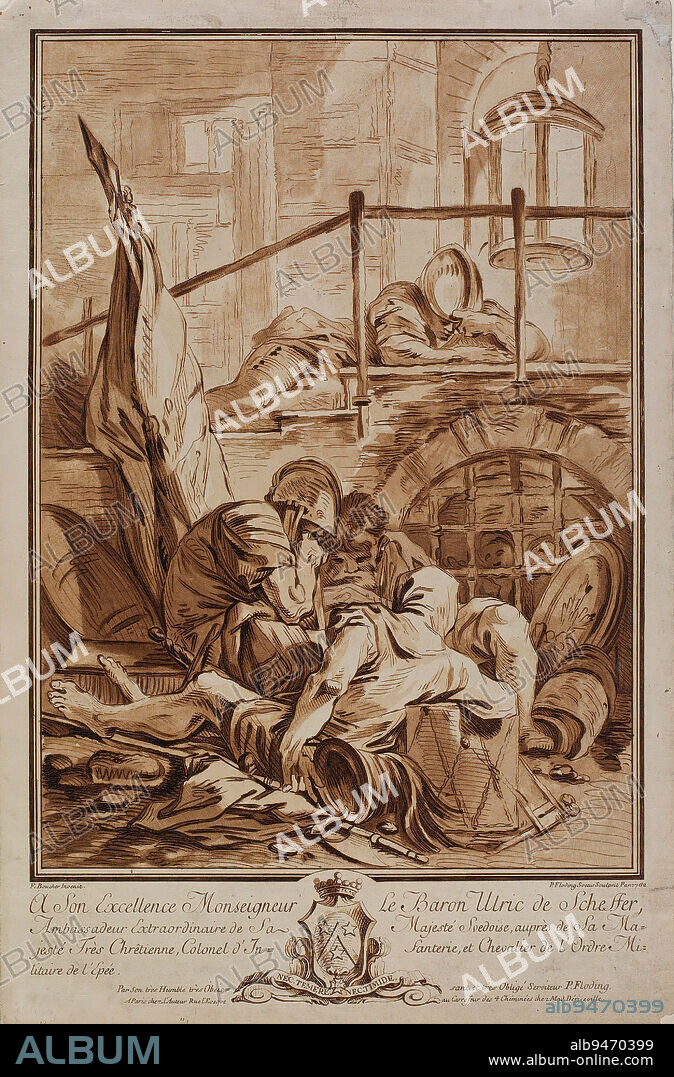alb9470399
Un Corps de Garde, 1762, Per Gustav Floding; Artist: after François Boucher, French, 17031770, 12 7/8 x 9 5/16 in. (32.7 x 23.65 cm) (plate)15 3/4 x 10 5/16 in. (40.01 x 26.19 cm) (sheet), Engraving, etching and aquatint (lavis) in bistre ink, Sweden, 18th century, In the 18th century, France and Sweden were strong military allies, and upperclass Swedes adopted French artistic trends. Born in Stockholm, Per Gustav Floding was sent to Paris as a young man to learn the art of engraving. He remained there for most of his career but retained close ties to his homeland. King Adolf Frederick was so pleased with a portrait that Floding made of him that he gave the artist money to re-equip his studio. This led directly to Flodings invention of a new printmaking technique, lavis aquatint. The technique involved covering the copper printing plate with powdered resin, heating it to make it adhere, and then subjecting it to repeated acid baths while selectively applying protective coatings between the successive immersions. The result is a field of minute dots of various sizes, which simulate the effect of dilute ink washes when printed.

|
Añadir a otro lightbox |
|
Añadir a otro lightbox |



¿Ya tienes cuenta? Iniciar sesión
¿No tienes cuenta? Regístrate
Compra esta imagen

Descripción:
Ver traducción automática
Un Corps de Garde, 1762, Per Gustav Floding; Artist: after François Boucher, French, 17031770, 12 7/8 x 9 5/16 in. (32.7 x 23.65 cm) (plate)15 3/4 x 10 5/16 in. (40.01 x 26.19 cm) (sheet), Engraving, etching and aquatint (lavis) in bistre ink, Sweden, 18th century, In the 18th century, France and Sweden were strong military allies, and upperclass Swedes adopted French artistic trends. Born in Stockholm, Per Gustav Floding was sent to Paris as a young man to learn the art of engraving. He remained there for most of his career but retained close ties to his homeland. King Adolf Frederick was so pleased with a portrait that Floding made of him that he gave the artist money to re-equip his studio. This led directly to Flodings invention of a new printmaking technique, lavis aquatint. The technique involved covering the copper printing plate with powdered resin, heating it to make it adhere, and then subjecting it to repeated acid baths while selectively applying protective coatings between the successive immersions. The result is a field of minute dots of various sizes, which simulate the effect of dilute ink washes when printed.
Crédito:
Album / quintlox
Autorizaciones:
Modelo: No - Propiedad: No
¿Preguntas relacionadas con los derechos?
¿Preguntas relacionadas con los derechos?
Tamaño imagen:
2744 x 4166 px | 32.7 MB
Tamaño impresión:
23.2 x 35.3 cm | 9.1 x 13.9 in (300 dpi)
Palabras clave:
ARTISTA • CALEFACCION • CALENTAR • CAMPO • FRANCES • FRANCOIS BOUCHER • IMPRESA • IMPRESO • SIMULAR • SUJETANDO
 Pinterest
Pinterest Twitter
Twitter Facebook
Facebook Copiar enlace
Copiar enlace Email
Email
